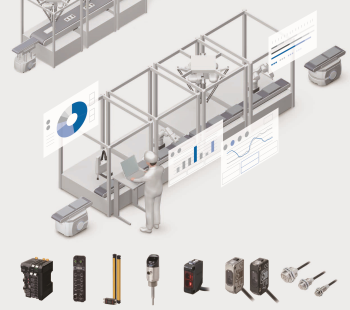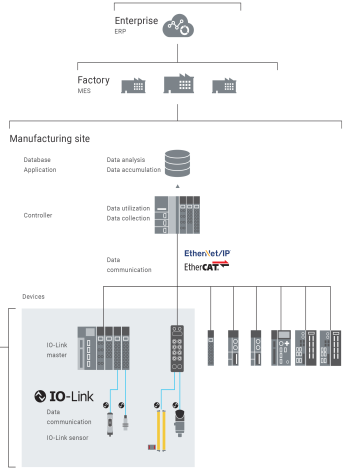
Understanding IO-Link
By Omron
Automation Machine BuildingA guide to the capabilities of the digital, IEC 61131-9-compliant communications networking standard.

(Photo credit: Omron)
Before the advent of IO-Link, the only data that could be gleaned from sensors was a basic on/off status. IO-Link provides an internationally accepted platform for sensors to report fault detection, condition monitoring and component identification. By communicating these details throughout the system, IO-Link helps shorten commissioning time while simplifying troubleshooting and reducing downtime occurrences to maximize production availability.
IO-Link meets the international standard IEC 61131-9 as an open information technology – or interface technology – between the sensor/actuator and the I/O terminal. It collects information from the sensor/actuator through the IO-Link Master via a fieldbus network into the host controller. This article will examine several questions manufacturers have when considering whether to use IO-Link for their applications.
What technologies are needed to use IO-Link?
A basic IO-Link system consists of one or more sensors/actuators with IO-Link functionality and an IO-Link master, which serves as the interface between the individual devices and the higher-level control system. An IO Device Description (IODD) is also required, as this particular file contains data that identifies each IO-Link-enabled device and describes its parameters, process data, diagnosis data, communication properties and more. Standard communication cabling is used to connect the devices to the master.
What types of data can be collected via IO-Link devices?
Essentially, IO-Link allows users to gather output data and monitor it over time. This information can be useful for predicting how long sensors will last in a given environment and can also be used to identify likely areas for process improvement so that the sensors will last longer. Additionally, users can take advantage of IO-Link to identify the vendor, product name and hardware revision in addition to collecting total runtime data and even temperature information. With the E2E NEXT DC 3-wire proximity sensors, users can know in real time – from a single location – the status of multiple sensors, in order to identify the location and cause of failures ahead of time
What are some key strategies for using IO-Link?
The most impactful way to employ IO-Link technologies is to use their alarm and data collection capabilities. By setting certain thresholds – for example, if a target gets too close to a proximity sensor, or if a photoelectric receiver is only getting a certain percentage of the light it normally receives – the technology can alert the operator to potential issues before they become more serious. Collecting data from the sensor and logging it into a database application that provides further analysis allows users to better predict when problems might arise. In addition, logging the data over time can reveal trends in equipment maintenance requirements that can be used to move from simple preventive maintenance to more effective predictive maintenance.
O-Link also provides a highly effective means of connecting sensors. For example, a single 8-port IO-Link master block can have IO-Link hubs attached to it, each of which can support up to 16 sensors. By doing this, a user can run up to 128 sensors from a single IO-Link master. By contrast, using EtherNet/IP distribution blocks, a distribution block would be required for every 16 sensors, and eight blocks would be needed to hook up 128 sensors. Distribution blocks are relatively expensive, and EtherNet/IP distribution blocks have the added disadvantage of requiring each block to have a separate IP address, whereas only the IO-Link Master requires an IP address in an IO-Link system
 What’s the potential impact of not using IO-Link?
What’s the potential impact of not using IO-Link?
Without using IO-Link, it would be more difficult to accurately predict when sensors might fail or cause other issues due to improper positioning. If these problems aren’t caught, the system might miss individual parts if sensing distances became too large, or the sensors could collide with sensing objects if the sensing distances were too short. The latter issue is a major cause of equipment downtime, as collisions can easily damage the delicate sensor technology. IO-Link helps manufacturers ensure a consistent sensing distance throughout the production line in order to keep detection rates high and avoid mechanical damage.
In addition, manually collecting sensor runtime data would be a tedious, error prone, and time-intensive process, as operators would need to manually log all runtime data. In addition, there would be no way for photoelectric sensors to automatically indicate when their lenses became dirty enough to impact their detection capability. Instead, operators would see a flickering “false on” or “false off” until the sensor finally locked on or off. A similar situation would be seen with proximity sensors as weld slag buildup starts to happen. IO-Link sensors can help manufacturers monitor sensor output in real time, rather than being notified only once the failed sensor condition occurs.
Yet another consequence of using devices that don’t incorporate IO-Link is a reduced ability to error-proof replacements for these devices. IO-Link master ports can be configured to recognize a specific part number, so if that part number needs to be replaced, the system can identify any mismatches and send an error alert. Without IO-Link, an operator could accidentally install the wrong part without raising any immediate alarms. This could cause false triggers, missed parts, or even damaged parts.
Finally, IO-Link technology makes replacement devices much easier to configure. Without IO-Link, operators need to go through a complex process of reconfiguring a new sensor to replace an old one. This process is made much easier with IO-Link, since the configuration that was used with the previous sensor can be set up to be automatically pushed to the new sensor once it’s installed. This saves time and also reduces the likelihood of an error.
How can IO-Link help manufacturers embrace Industry 4.0?
Across industries, a willingness and ability to implement Industry 4.0 technologies is becoming a prerequisite for success in the manufacturing environment of the near future. Next-generation factories are built upon a foundation of data that tracks the location and status of works-in-progress and monitors the functionality of equipment. Also known as the Industrial Internet of Things (IIoT), this assortment of technologies is being developed to serve the need for collecting and utilizing information from the plant floor to improve processes and facilitate predictive maintenance.
IO-Link fully supports movements toward plant connectivity and IIoT by collecting machine and process data at the device level. As production lines trend simultaneously towards more flexibility and more automation, it becomes increasingly difficult for operators to comprehensively monitor machine function and predict when repairs will be needed. By collecting machine data at the device level and storing this data for future analysis, IO-Link technologies help manufacturers stay on top of important predictive maintenance needs.
IO-Link technologies provide an excellent way to collect the data necessary to provide a foundation for improving process flow and facilitating predictive maintenance as today’s manufacturing applications grow in complexity. IO-Link-enabled sensors contain important machine-level information that compliments the data gleaned through traceability and vision inspections. Without IO-Link, sensors can only provide a simple on/off status reading.
In addition, IO-Link makes key components of any application much easier to set up and maintain. With an internationally accepted platform for sensors to report fault detection, condition monitoring and component identification, it shortens commissioning while reducing troubleshooting needs and downtime instances. Replacement devices are much easier to incorporate when IO-Link can automatically push the original settings to the new device from the IO-Link master.
https://automation.omron.com
This article was contributed by Omron.
